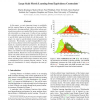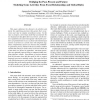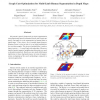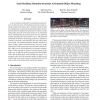CVPR
2012
IEEE
12 years 2 months ago
2012
IEEE
Activity recognition in video is dominated by low- and mid-level features, and while demonstrably capable, by nature, these features carry little semantic meaning. Inspired by the...
CVPR
2012
IEEE
12 years 2 months ago
2012
IEEE
In this paper, we raise important issues on scalability and the required degree of supervision of existing Mahalanobis metric learning methods. Often rather tedious optimization p...
CVPR
2012
IEEE
12 years 2 months ago
2012
IEEE
This paper addresses the discovery of activities and learns the underlying processes that govern their occurrences over time in complex surveillance scenes. To this end, we propos...
CVPR
2012
IEEE
12 years 2 months ago
2012
IEEE
Fine-grained categorization refers to the task of classifying objects that belong to the same basic-level class (e.g. different bird species) and share similar shape or visual app...
CVPR
2012
IEEE
12 years 2 months ago
2012
IEEE
We present a generic framework for object segmentation using depth maps based on Random Forest and Graph-cuts theory, and apply it to the segmentation of human limbs in depth maps...
CVPR
2012
IEEE
12 years 2 months ago
2012
IEEE
This paper presents a novel method for estimating the geospatial trajectory of a moving camera with unknown intrinsic parameters, in a city-scale urban environment. The proposed m...
CVPR
2012
IEEE
12 years 2 months ago
2012
IEEE
Trajectory basis Non-Rigid Structure From Motion (NRSFM) currently faces two problems: the limit of reconstructability and the need to tune the basis size for different sequences....
CVPR
2012
IEEE
12 years 2 months ago
2012
IEEE
A novel method is proposed for matching articulated objects in cluttered videos. The method needs only a single exemplar image of the target object. Instead of using a small set o...
CVPR
2012
IEEE
12 years 2 months ago
2012
IEEE
We present a photometric stereo technique that operates on time-lapse sequences captured by static outdoor webcams over the course of several months. Outdoor webcams produce a lar...
CVPR
2012
IEEE
12 years 2 months ago
2012
IEEE
We propose an approach to improving the detection results of a generic offline trained detector on a specific video. Our method does not leverage visual tracking as most detecti...




